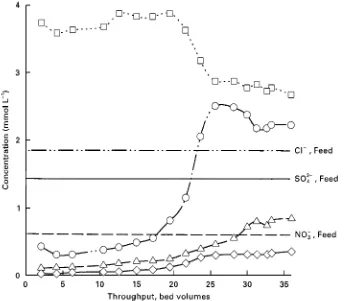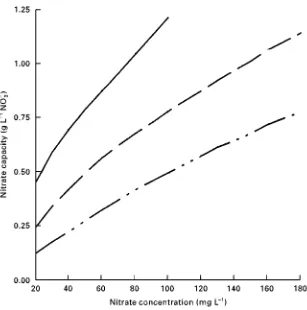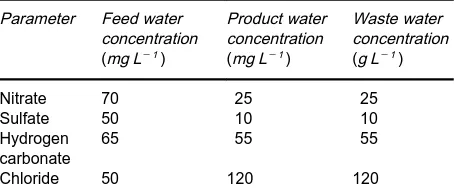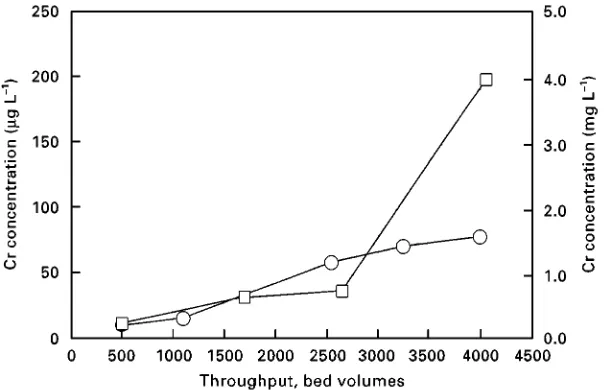Newell PA, Wrigley SP, Sehn P and Whipple SS (1996) An economic comparison of reverse osmosis and ion exchange in Europe. In: Greig JA (ed.) Ion Exchange Development and Applications, pp. 58}66. Cambridge: Royal Society of Chemistry.
Nolan J and Irving J (1984) The effect on the capacity of strong base anion exchange resins of the ratio of chloride to sulphate in the feed water. In: Naden D and Streat M (eds)Ion Exchange Technology, pp. 160}168. Chi-chester: Ellis Horwood.
Anion Exchangers: Ion Exchange
W. H. Ho]ll, Karlsruhe Nuclear Research Center, Karlsruhe,Germany
Copyright^ 2000 Academic Press
Introduction
Anion exchange resins consist of a polymeric matrix to which different functional groups are attached. Most weakly basic anion exchangers contain tertiary amino groups; in a few cases primary and secondary groups are also encountered. In many cases weakly basic anion exchangers are not monofunctional but possess a variety of amino groups. Strongly basic resins contain quaternary ammonium groups. Stan-dard commercially available exchangers con-tain either }N#(CH3)3 groups (type 1 resins) or }N#(CH3)2C2H4OH groups (type 2 resins). Both weakly and strongly basic exchange resins are avail-able in gel-type or macroporous modiRcations.
Properties andRelds of application mainly depend on the dissociation properties of the functional groups in which dissociation plays the most impor-tant role. By means of the mass action law, dissoci-ation constants of the protonated amino and ammonium groups can be estimated. The respective numerical values are in the range of pKa'13 for strongly basic resins and 5}8 for weakly basic resins. Therefore, strongly basic resins are protonated over the entire pH range but weakly basic exchangers are protonated at pH values below 5}8, depending on the type. As a consequence, strongly basic resins will exchange anions in both acid and alkaline solutions. In addition, these exchangers can adsorb weak acids and even ionize very weakly dissociated acids. Weak-ly basic resins, however, can operate onWeak-ly in acidic media and are unable to convert neutral salts to the respective hydroxides (e.g. NaCl to NaOH). Further-more, they cannot normally adsorb weak acids.
The uptake of anions by resins is subject to speciRc interactions between counterions and co-ions and the distribution of exchangeable ions depends on the properties of both the exchanger and the ions. Conse-quently, a favoured sorption of certain types of anions occurs. The sequence of afRnities is given either qualitatively by the selectivity series or
quantit-atively by, for example, separation factors. For weak-ly basic anion exchangers the sequence of most com-mon anions in fresh water is:
OH\SO2\
4 'NO\3'Cl\
Due to the dissociation properties of the functional groups, hydroxyl ions are strongly preferred. This is important for the conversion of these resins to the hydroxyl (or free base) form in the regeneration step, in which only slightly more than the stoichiometric amount of OH}bearing solutions is required.
For strongly basic anion exchangers the selectivity series is:
SO2\
4 'NO\3'Cl\'HCO\3'OH\
For these resins hydroxyl ions are the least prefer-red among the standard anions. Conversion of the resins to the hydroxyl form therefore requires com-paratively large excess amounts of sodium hydroxide. For elimination of nitrate anions from drinking water the preferred sorption of sulfate ions causes considerable disadvantages. Extensive research dur-ing the 1980s has shown that this drawback can be overcome by introducing functional groups which are more hydrophobic and bulkier. By these means, the ability to adsorb sulfate ions is considerably de-creased. The so-called nitrate-selective resins which are now commercially available contain triethyl in-stead of trimethyl groups and, therefore, exhibit a re-versed preference for nitrate and sulfate ions.
The rate of exchange depends mainly on the inter-nal interdiffusion of exchanging ions. On the com-pletely ionized strong base resins this diffusion is rather quick and the overall rate of exchange mainly depends on the particle size distribution. With weakly basic exchangers, however, the poor dissociation and further speciRc interactions between functional sites and diffusing ions considerably slow the rate of ex-change. For these resins, both the uptake of acids and conversion to the free base form by means of sodium hydroxide strongly depend on the concentration of the liquid phases.
functional groups at temperatures above 403C, lead-ing to a loss of strongly basic functionality. Weakly basic exchangers are very stable.
Applications
Water Demineralization
The most important application of anion exchangers in water treatment has been in demineralization pro-cesses. Demineralization consists of the subsequent cation exchange for hydrogen ions as the Rrst step and either adsorption of acids by a weakly basic exchanger or real anion exchange for hydroxyl ions on a strongly basic exchanger as the second step. As a result, demineralized water is produced: this may be used for various purposes, such as boiler feed water.
The efSuent from the preceding cation exchange step consists of a mixture of strong mineral acids and carbonic acid; this is equivalent to the cations originally dissolved. Furthermore it contains silica and dissolved organic compounds, neither of which are retained by the cation exchangers. If no silica removal is needed, weakly basic anion exchangers in their free base form are used to remove strong mineral acids. This process develops as the uptake of acids:
R3N#(HCl, H2SO4)0R3NH##(Cl\, SO2\ 4 ) [1]
(Parantheses are used to express the stoichiometry of the exchange; R3 denotes the matrix of the weakly basic exchanger.) In technical Rlter columns the uptake of sulfuric and hydrochloric acid results in the development of zones with different predominant loadings: Rrstly, a sulfate-rich zone close to the inlet; secondly, a chloride zone; and Rnally, a zone in which the resin is still in the free base form. During the Rlter run the sulfate and chloride zones become larger and the boundaries between the zones are shifted towards the column outlet. Consequently, chloride ions are the Rrst to appear in the column efSuent.
Theoretically, the strong acids should be com-pletely eliminated. In practical installations, however, the leakage of sodium from the strongly acidic cation exchanger cannot be avoided and it is in the range of 2}50g L\1, depending on the level of regeneration. By this means, the feed solution for the anion ex-changer contains some neutral salt which cannot be eliminated. Consequently, an equivalent amount of chloride ions remains in the efSuent. Apart from this sodium leakage-caused ‘slip’, the presence of chloride
ions may also be due to the hydrolysis of the hydro-chloride form of weak base resins:
R3NH#Cl\0R3N#HCl [2]
Weak acids like carbonic acid are only adsorbed to a small extent and hydrogen carbonate ions are rap-idly replaced by anions of strong acids. Carbonic acid or CO2 is therefore eliminated either by physical degassing or by means of a strongly basic exchanger. Since the capacity of weakly basic resin increases with increasing total ionic concentration (to which carbon-ic acid contributes), degassing of CO2is often placed after the weakly basic exchangerRlter.
Regeneration of weakly basic anion exchangers is usually carried out by means of sodium hydroxide, although other chemicals like Ca(OH)2 or am-monium hydroxide have also been proposed. To avoid the precipitation of calcium sulfate, the regen-erant solutions of anion exchangers generally require calcium-free water. Since the strong acids are easily neutralized, regeneration is efRcient. The operating capacity depends on the composition of the raw water and the resulting loading of the anion ex-changer. If equal amounts of caustic are applied in the regeneration step, the effective capacity decreases by about 10% if the raw water contains exclusively sulfate instead of only chloride ions.
Unlike with weakly basic resins, the removal of acids by a strongly basic resin develops as a neutral-ization reaction:
R4N#OH\#(HCl, H2SO4)
0R4N#(Cl\, SO2\
4 )#H2O [3]
(R4 denotes the matrix of the strong base resin.) Because of the high pH value in the resin phase, strongly basic exchangers can ionize and adsorb ions from carbonic acid and even from silica:
R4N#OH\#H2CO30R4N#HCO\3#H2O [4]
R4N#OH\#H4SiO40R4N#H3SiO\4#H2O [5]
Figure 1 Interdependence of sodium and silica leakage.
During the accumulation in the resin phase, silica starts to polymerize. This is favoured by long cycles as well as by high concentrations in the feed water. Regeneration using NaOH may, therefore, become a dissolution rather than a true ion exchange process. Warm solutions (approximately 503C) are consider-ably more effective than solutions at ambient temper-ature. In addition, regeneration may be adversely inSuenced by the mode of regeneration and the pos-sible displacement of hydrogen carbonate ions. The leakage of silica is closely related to the leakage of sodium in the preceding cation exchanger (Figure 1). Regeneration of strongly basic resins is generally carried out by means of NaOH at concentrations between 1 and 5%. As with weakly basic exchangers, the resulting operating capacity depends on the com-position of the feed water, the relative amount of NaOH, temperature and, to a certain extent, the rate ofRltration during regeneration. The relative quanti-ty of NaOH required is considerably higher than for weak base resins and lies between 150 and 250%of the stoichiometric amount. For the slightly weaker basic resins of type 2, the operating capacities are higher than for type 1 resins.
There can therefore be savings in chemicals and cost if the anion exchange step is split into two stages. In theRrst stage a weakly basic resin is applied for the elimination of strong acids. After physical degassing to remove carbon dioxide, the strongly basic ex-changer is exclusively used to eliminate the remainder of the carbonic acid and silica. Both resins are regen-erated together: the NaOH solution Rrst passes through the strongly basic resin which requires a con-centrated regenerant without impurities. The efSuent
then passes the weakly basic resin. Due to the strong preference for hydroxyl ions, considerable levels of impurities can be tolerated.
Demineralization of water by subsequent or simultaneous cation/anion exchange has been realized in countless installations for both fresh and waste water treatment. It has become extremely important for boiler feed water and for ultrapure water for the electronics and pharmaceutical indus-tries. Typical conditions to be met are conductiv-ities below 0.2S cm\1 and silica concentrations (5 mg L\1.
Partial Demineralization of Drinking Water
In Europe numerous water supplies distribute drink-ing water with elevated total hardness caused by the presence of sulfate and calcium ions. Treatment of such water, therefore, requires the elimination of sul-fate ions parallel to diminishing hardness. In such applications complete demineralization is not re-quired. Consequently, considerable leakage of the ion exchangers can be tolerated. The condition of simul-taneously diminishing the concentrations of alkaline earth and sulfate ions is met by the carbon dioxide regenerated ion exchange (CARIX) process. This process uses a mixed bed consisting of a weakly acidic resin in the free acid form and a strongly basic resin in the hydrogen carbonate form. In contact with cal-cium- and sulfate-bearing raw water, both kinds of ions are replaced by carbonic acid:
RCCOOH RCCOO\(Ca2#)
#(Ca2#, SO2\ 4 )0
R4N#HCO\3 R4N#(SO24\)
#H2CO3 [6]
Figure 2 Concentration histories of chloride, nitrate and sulfate in the Carix process. Feed alkalinity (HCO3\): 6.5 mmol L\1. Circles, Cl\; triangles, NO\3; diamonds, SO24\; squares, HCO\3.
Table 1 Partial demineralization by means of the CARIX process
Parameter Raw water Product water
Total hardness 5.4 mmol L\1 2.3 mmol L\1 Hydrogen carbonate 6.6 mmol L\1 3.4 mmol L\1 Sulfate 1.6 mmol L\1 0.35 mmol L\1 Nitrate 0.6 mmol L\1 0.45 mmol L\1 Chloride 1.5 mmol L\1 1.3 mmol L\1 Conductivity 930S cm\1 470S cm\1 pH Value 7.30 7.80 CARIX process can be adapted to the objective
of treatment by adjusting the volume ratio
Vanion:Vcation of the two resins in the range of 3 : 1 to 1 : 3. With respect to both the removal of sulfate and regeneration by means of carbonic acid, type 2 and acrylic anion exchangers show the best results.
So far, the process has been realized in three full-scale plants in water works in Germany. Each of these plants consists of one or two sets of threeRlters which operate in a merry-go-round mode. The total throughput for eachRlter between two regenerations is 35}50 bed volumes. After half of the total through-put, a secondRlter starts its service cycle. After the full throughput, theRlter is regenerated and waits for the next service cycle while the third one is started. The product water is the mixed efSuent of the two operating Rlters. Typically, about 10% of the raw water is needed for regeneration. From the waste water, 90% of the unspent carbon dioxide is re-covered. Thus, the consumption of CO2amounts to 0.4}0.45 kg m\3.
Figure 2shows a typical breakthrough history for
standard anions. Average product water concentra-tions are listed inTable 1.
Nitrate Removal
For many drinking water supplies the presence of nitrate in ground and surface water at elevated con-centrations has become a serious problem because of its health effects. As the simplest possibility, nitrate can be eliminated from water by means of strong base anion exchangers in the chloride form:
R4N#Cl\#(NO\3, SO24\, HCO23\)
0R4N#(NO\3, SO42\, HCO23\)#Cl\ [7]
Figure 3 Operating capacity of a type 2 strongly basic anion exchanger depending on the concentrations of nitrate and sulfate in the raw water. Continuous line, 0.36 mmol L\1; dashed line, 0.72 mmol L\1; dotted and dashed line, 2.1 mmol L\1. Resin: Lewatit M600. preferred uptake of sulfate ions. Consequently,
the nitrate uptake capacity strongly depends on the sulfate/nitrate concentration ratio in the raw water. As an example, for a type 2 resin the nitrate uptake capacity decreases by 60% if the sulfate concentration in the feed increases from 50 to 220 mg L\1.
During the uptake of sulfate, nitrate and hydrogen carbonate by a chloride-loaded conventional anion exchanger, loading zones develop in theRlter column: a sulfate-rich zone, a nitrate-rich section and a mixed chloride/hydrogen carbonate zone followed by the resin in its original chloride form.
Due to the development of the zones and the dis-placement of less preferred anions, continuous change occurs in the efSuent composition. When the hydrogen carbonate-rich zone has reached the outlet there is still removal of nitrate species, but an increase in the concentration of hydrogen carbonate and a cor-responding increase in the pH in the efSuent occur. The column run has to be stopped when the nitrate-rich zone reaches theRlter outlet.
Regeneration is carried out using brine solutions of 2}10%NaCl:
R4N#(SO2\
4 , NO\3)#NaCl
0R4N#Cl\#(Na2SO4, NaNO3) [8]
The total quantity of NaCl used depends on the tolerable nitrate leakage in the service cycle. To achieve efSuent concentrations42 mg L\1, the re-quired amount is 5200 g L\1 resin. With smaller quantities the leakage becomes larger.
The operating capacity of conventional anion ex-changers depends on both the nitrate and sulfate concentrations of the feed water.Figure 3shows the respective interdependence for a commercially avail-able type 2 resin.
The objective of treatment normally does not con-sist of the complete elimination of nitrate but only of its reduction below the maximum permitted concen-tration. A tolerable nitrate concentration in the prod-uct water can therefore be achieved by two different methods: theRrst uses an exchanger which has been regenerated with a large amount of NaCl. Since the leakage of the column is small, only part of the water has to be treated and can be blended with a by-pass of untreated water.
Table 2 Data of operation of Ecodenit plant
Parameter Feed water concentration (mg L\1)
Product water concentration (mg L\1)
Waste water concentration (g L\1)
Nitrate 70 25 25 Sulfate 50 10 10 Hydrogen
carbonate
65 55 55
Chloride 50 120 120
and rinsing of the exhausted resin. After exhaustion the resin material in the contacting section is pulsed into the back-wash part, whereas regenerated and rin-sed resin material enters the contacting section. The plant was designed for a maximum throughput of 277 m3h\1. The nitrate concentration was diminished from 100 to 43 mg L\1as the tolerable maximum.
In the second possibility the amount of NaCl re-quired during regeneration is smaller. As a conse-quence, the regeneration is less efRcient and the nitrate leakage becomes larger. Thus, all the water has to be treated. This principle is shown in the Ecodenit process developed in France. This process operates with NaCl quantities of 4100 g L\1 of resin and uses co-Sow regeneration. The Rrst full-scale plant for the treatment of 160 m3h\1 is in service in northern France. This plant consists of three Rlters operating in a merry-go-round mode. Each Rlter contains 8 m3 of a strongly basic resin. Results of the operation of the full-scale plant are summarized inTable 2.
Both principles are combined in a third modiR ca-tion. Such a plant went into service in 1983 in Cali-fornia. The plant was to treat 115 m3h\1 blended with 45 m3h\1 raw water. It consists of three col-umns which are also operated in a merry-go-round mode. For each Rlter the throughput between two regenerations amounts to 250 bed volumes. The nitrate concentration is decreased from 71 to 11.5 mg L\1in the mixed efSuent of the serviceRlters and to 27}36.5 mg L\1in the blended product water. Since 1983, numerous nitrate elimination plants have come into service: most apply nitrate-selective ex-changers.
Chromate Removal
Chromic acid and chromates are widely used in many applications. Anion exchange offers an ideal oppor-tunity for the removal and recovery of chromates. Both strongly and weakly base resins can be applied. In aqueous solutions chromate ions exist in differ-ent ionic forms. The speciation mainly depends on the pH value. In the acidic region (1(pH(6.5) and for
dilute solutions, HCrO\4 is the predominant species. Above pH 6.5 mostly CrO2\
4 is found. With respect to ion exchange processes it is important that dimeriz-ation occurs at elevated concentrdimeriz-ations:
2HCrO\4 0Cr2O27\#H2O [9]
The respective pH conditions may exist in the anion exchanger phase. Therefore, the resins can be considered to be at least partly loaded with Cr2O27\ species.
Chromate species are strongly preferred over chlor-ide and sulfate ions under normal conditions. How-ever, at acidic pH this preference vanishes for both weakly and strongly basic anion exchangers when chromate is the trace component. Consequently, Rxed-bed experiments using standard acidic chro-mate-bearing waste waters exhibit a gradual increase in the efSuent concentration. An increase in the con-centration of competing sulfate ions yields only a neg-ligible decrease in chromate capacity. In contrast to this, an increase in the chloride concentration leads to a considerable decrease in chromate capacity for a given liquid-phase concentration. For weakly basic resins the chromate capacity decreases with increas-ing pH because of the deprotonation of the functional groups. Below pH 5 the capacity is constant and depends only on the background composition of the solution.
Using strongly basic exchangers chromate can be removed by the following exchange processes:
R4N#OH\#(CrO2\
4 )0R4N#(CrO24\)#(OH\) [10]
R4N#Cl\#(Cr2O2\
7 )0R4N#(Cr2O27\)#(Cl\) [11]
Weak base anion exchangers are applied, for example in the sulfate form:
R3N#(SO2\
4 )#CrO24\0R3N#(CrO24\)#SO24\ [12]
R3N#(SO24\)#Cr2O27\0R3N#(Cr2O27\)#SO24\ [13]
AcidiRcation of the feed solution leads to the formation of hydrogen dichromate species, which doubles the capacity of the resins, e.g.:
R3N#(Cr2O2\
7 )#Cr2O27\#H2SO4
Figure 4 Elimination of Cr(VI) from cooling tower blowdown. Effluent concentration histories of loading (circles) and polishing (squares) columns. Feed water composition: Cl\(500 mg L\1), SO2\
4 (200 mg L\1), Cr(VI) (10 mg L\1), HCO3 (100 mg L\1), Ca2##Mg2#(5.5 mmol L\1), Na#(250 mg L\1). Resin: Amberlite IRA 94.
After exhaustion, treatment with NaOH will con-vert hydrogen dichromates to chromates and, sub-sequently, yield half of the chromate loading on elution. Removal of the remainder of the chromate from the strongly basic exchanger requires concen-trated sodium sulfate solutions:
R4N#(CrO2\
4 )#Na2SO4
0R4N#(SO2\
4 )#Na2CrO4 [15]
In contrast to strongly basic exchangers, weakly basic ones can be completely regenerated by means of NaOH. However, before the following service cycle, the resins have to be reconverted to the sulfuric acid form:
R3N#(CrO24\)#2NaOH0R3N#Na2CrO4 [16]
R3N#H2SO40R3N#(SO2\
4 ) [17]
Chromate species elimination from cooling tower blowdown has been achieved by application of a styrene weakly basic resin in a merry-go-round system with three columns. In the plant, column 1 serves as the crude loading column which eliminates most of the chromate. The relatively low efSuent concentrations are further decreased by the second (polisher) column. The third column is regen-erated/conditioned or waits for service. When the maximum tolerable efSuent concentration of the polisher column is exceeded, the sequence is switched
so that the polisher column now acts as the loading column and the freshly regenerated Rlter is applied for polishing. The previous loading column is regen-erated and conditioned. A typical example is given in
Figure 4.
Removal of Organic Substances
Natural organic substances normally have an anionic nature at pH values above neutral. Apart from their elimination in a suitable pretreatment step, they can be adsorbed by both weakly and strongly basic anion exchangers. Uptake of organic substances is due to both ionic and van der Waals forces. They may pres-ent a problem for anion exchangers because of a pos-sibly irreversible adsorption by styrene-based gel-type resins.
Both types of exchangers, therefore, can act as scavengers for the removal of organic compounds prior to further ion exchange steps. In general, strong-ly basic exchangers exhibit a better elimination of humic substances. For demineralization of industrial water they are applied in the chloride form as scaven-ger units at the head of the deionization train. The basic problems associated with the application of anion exchangers as scavengers in demineralization plants are the additional exchanger unit and the ex-change of the organics and hydrogen carbonate ions for chloride. Thus, the efSuent composition may be less favourable for the application of weakly acidic exchange resins.
resins has been successfully applied in the Stratabed威 concept, in which two layers of the respective resins, both of the polystyrene type, are used. The applica-tion of this concept requires the use of exchange resins with a particle size distribution which allows the maintenance of the stratiRed bed in each column. Since regeneration is carried out using warm NaOH solution, precipitation of silica is avoided. Favourable conditions are met: waters of poor alkalinity and chloride and sulfate are the major part of the anions present. Acrylic anion exchangers allow a reversible uptake of humic acids. Although the capacity of acrylic resins for organics is poorer, they are highly effective. They can be used in all applications except in condensate polishing with extremely high Sow rates. Under these conditions the elastic properties of these resins exclude their use.
At low levels of organic matter in the feed water the application of macroporous weakly basic resins in their free base form in the de-ionization train allows an efRcient removal. Furthermore, these resins are less susceptible to irreversible fouling.
In drinking water treatment, macroporous styrene-based strong base resins were employed in Hanover in Germany as a single treatment step for the removal of organic matter from ground water. Dissolved or-ganic carbon was to be reduced from 6.5 to about 3 mg L\1. After 5000 bed volumes, the resin was regenerated by means of an alkaline NaCl solution which could be reused seven times. The plant was shut down in 1995.
Apart from the elimination of natural organic matter, anion exchangers may also be applied to the removal of organics from different types of waste water. Weakly basic resins have been used for the removal of phenol. Sorption is carried out at rather low Sow rates of 2}8 BV h\1. NaOH or organic solvents are used for regeneration. Macroporous weakly basic resins in the sulfuric acid form are ap-plied for decolorization of kraft bleach liquors. After exhaustion they are regenerated using NaOH and conditioned by means of sulfuric acid.
See also: I/Ion Exchange. III/Water Treatment: Over-view: Ion Exchange. Resins as Biosorbents: Ion Exchange.
Further Reading
Bayer AG (1974)Lewatit-Lewasorb Manual. Leverkusen: Bayer.
Bolto BA and Pawlowski L (1987)Wastewater Treatment by Ion Exchange. London: E.&F. Spon.
Dorfner K (1991) Ion Exchangers. Berlin: Walter de Gruyter.
Harland CE (1994)Ion Exchange, Theory and Practice. Bath: Bath Press.
Kunin R (1996) Amber-hi-lights. Littleton, CO: Tall Oaks.
Mitsubishi Chemical. Diaion Manual of Ion Exchange Resins and Synthetic Adsorbents. Mitsubishi Chemical. SenGupta AK (ed.) (1995) Ion Exchange Technology.
Lancaster and Basel: Technomic.
WATER-SOLUBLE VITAMINS: THIN- LAYER
(PLANAR) CHROMATOGRAPHY
See III / VITAMINS/WATER-SOLUBLE: THIN-LAYER (PLANAR) CHROMATOGRAPHY




